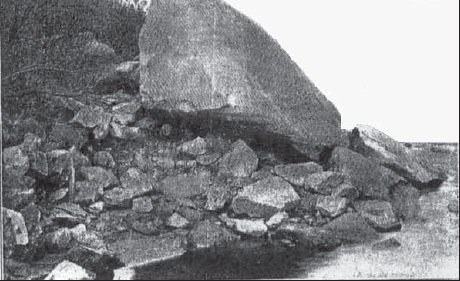Written by Tom Anderton.
Originally published in Ancient American magazine issue #83.
A rock shelter near Van, Pennsylvania known as “Rainbow Rock” features the carvings of snakes, a human figure, apparent bird tracks and dots, as described by The Pennsylvania Archaeologist (Vol. 42, No. 3, September 1972). While these images are common visual components of petroglyphs found across North America, the elephant depicted inside a rectangle on the face of a large stone standing near “Rainbow Rock” is not.
James L. Swauger, an expert in prehistoric rock art with more than seventy published reports dealing primarily with petroglyphs in the Ohio Valley, examined the elephant portrayal. “It is obvious at this time that the figure was carved recently by persons using metal tools, and that it has no relationship to the undoubted American Indian petroglyphs of the site,” he concluded in “The Bunola Head, A Forgery”, for The Pennsylvania Archeologist, Vol. 30, No. 2, Gettysburg. “Leo T. Sarnaki Carnegie Museum Photographer, concurred in this opinion, as did the half dozen others with whom I visited this site.”
While Swauger and company are correct in pointing out that pre-Columbian Indians used stone tools, their assumption that the Rainbow Rock pachyderm must be, ipso facto, a modern fake, because it was carved with a metal utensil, is only an assumption. Large numbers of ancient arrowheads, spear-points and related items of hardened copper have been found especially in Upper Michigan since the early 19th Century. They comprise a great body of physical evidence on behalf of metal tools used by the prehistoric residents of our continent. Of course, Swauger was far more disturbed by the representation of an elephant, a creature mainstream academics such as himself insist was totally unknown to the pre-modern inhabitants of North America.
But the Pennsylvania petroglyph is hardly the only such image found in the state. In 1872, a farm boy working his fields near Doylestown, Pennsylvania, accidentally plowed up a five-inch-long stone covered with strange symbols on one side. On the other was “a scene which could only be interpreted as a pictographic account of an Indian encounter with a mammoth” as described in a 1972 NEARA Newsletter article (7:16-18) by Richard L. Greene. The Lenape Stone, named “after a local branch of the Delaware Indians,” was investigated and deemed authentic by Buck County Historical Society spokesman, Henry C. Mercer.
At least half a dozen Wisconsin effigy mounds shaped into the unmistakable configuration of elephants were personally studied and documented during the late 1800s by the professional surveyor, T.S. Lewis, whose life’s work is preserved on microfilm at the Minnesota Historical Society Museum, in Saint Paul.
In their hasty dismissal of the Rainbow Rock elephant petroglyph as “a forgery”, conventional archaeologists may have yet again condemned a possibly valuable insight into North American prehistory. The price of such high-handed neglect is often destruction, a case in point being northwest Pennsylvania’s so-called “Indian God Rock”
Found in Venango County, some eight miles form the city of Franklin, a flat sandstone surface twenty-two feet high and fourteen feet wide is positioned at a fifty-degree angle to the east bank of the Allegheny River, not far from its confluence with French Creek. The site was covered with profuse rock art when first described by the French explorer, Blenville De Celoron, in 1749. Although he did not copy the inscriptions, they were still in tact more than one hundred years later, as confirmed by the famous antiquarian, Henry Schoolcraft, in his 1853 publication, Indian Antiquities.
Since then, however, “Indian God Rock” has been severely vandalized, so much so its ancient petroglyphs have been almost entirely effaced. Perhaps, like “Rainbow Rock”, with its offensively anomalous elephant image, it was neglected by mainstream scholars, who thereby consigned more of our country’s prehistory to oblivion.






